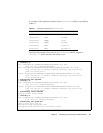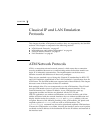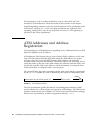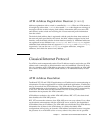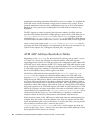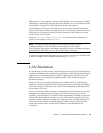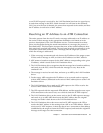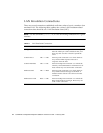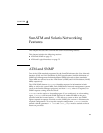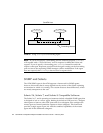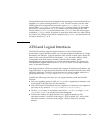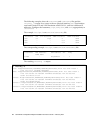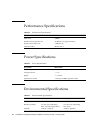
Chapter 7 Classical IP and LAN Emulation Protocols 71
as an IP ARP request) is received by the LAN Emulation host from its upper layers,
it sends that message to the BUS, which forwards it to all hosts in the emulated
LAN. Just as in the case of ethernet, the correct host responds to the sender, and thus
the IP address is resolved to a MAC address.
Resolving an IP Address to an ATM Connection
The entire process from the time IP sends a message addressed to an IP address to
the arrival of that message at the appropriate destination was hinted at in the
previous descriptions of the LAN Emulation servers. To demonstrate how those
pieces work together during the actual transmission of a message, the process is
described below. This description assumes that none of the needed addresses have
been previously resolved and cached. The two hosts involved are referred to as the
source (the system that wishes to send a message) and the target (the system to
which the message is addressed).
1. IP has a message to transmit and only knows the IP address of the target system.
IP first sends a message to ARP, to resolve the IP address to a MAC address.
2. ARP creates a broadcast request for the MAC address corresponding to the given
IP address, which it sends to the LAN Emulation driver.
3. The LAN Emulation driver recognizes that this message has a broadcast address,
and sends it to the BUS, which forwards the message to every host on the
emulated LAN.
4. The message is received on each host, and sent up to ARP by the LAN Emulation
driver.
5. On the target, ARP recognizes the IP address as its own and sends a response
with its MAC address (addressed to the source’s MAC address) down to the LAN
Emulation driver.
6. The LAN Emulation driver sends an LE ARP request to the LES to resolve the
source’s MAC address to its ATM address.
7. The LES responds with the requested ATM address, and the target host sets up an
ATM connection to the source host, over which it sends the IP ARP response.
8. The LAN Emulation driver on the source receives the IP ARP response message
and sends it up to ARP. ARP then inserts the MAC address into the original
message and sends it back down to the LAN Emulation driver.
9. The LAN Emulation driver then must send an LE ARP request to the LES to
resolve the MAC address in the message from ARP to an ATM address. When it
receives an LE ARP response, it then sees that it has a connection to that address
(established by the target to return the IP ARP response) and sends the original IP
message to the target over that connection.



